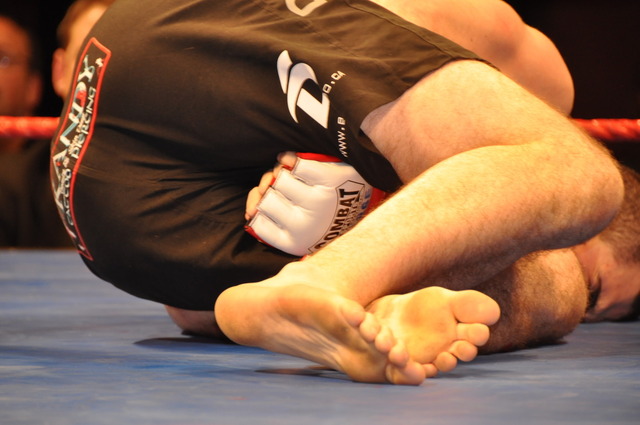With the Ultimate Fighting Championship (UFC) finally coming to Albuquerque, local fight fans will be ratcheting up their public displays of combat affinity. Albuquerque has a long and proud boxing tradition, and in recent years has been supplying a steady stream of world-class talent to the UFC and other promoters of the new and fast-growing sport of Mixed Martial Arts (MMA). It may come as news to some, but there is also a subset of the local population whose life circumstances have not lent themselves to any interest, much less proficiency, in hand-to-hand combat. This article is for you. It’s a little background on cage fighting with an explanation of why I, a non-violent guy, am into this sport. You’ll find a little history, a little explanation of the rules (yes, there are things you can’t do) and hopefully a little evidence that there is more to this sport than stupid t-shirts with skulls on them.To me, there are two general categories of sport: those that imply some kind of genuinely useful skill and those that don’t. Running, shooting, hunting and fighting are real skills that could literally save your ass in a survival situation. Shooting a three-pointer, by contrast, not so much.If you want pure competition, where the winner demonstrates a meaningful advantage over the loser, you can’t get more real than two men, stripped to the waist, fighting in a cage (or two women, not quite stripped to the waist).The sport of mixed martial arts began, with UFC 1 in 1993, as a competition not only between martial artists, but between different martial arts. It was kickboxers vs. sumo wresters, and karate fighters vs. Brazilian jiu-jitsu specialists. The sport quickly evolved, with fighters eventually realizing that the most effective style, given the rules and scoring criteria, was a hybrid of wrestling, submission grappling (such as jiu-jitsu or judo) and one of the striking arts, most commonly Muay Thai, a kickboxing style from Thailand.The Ultimate Fighting Championship is the undisputed major leagues of MMA. And when it touches down in the Duke City, many locals will feel like the MMA Mothership has finally come home to port. The fan base is as rabid as you’ll find, and with noted gyms like Jackson-Winkeljohn MMA turning out a steady stream of world class talent, it’s an event that’s long overdue. Televisions at home and in most bars in town will be tuned to the live broadcast on Fox. The roof of Tingley Coliseum, where the action takes place, will be beating like a drum, the collective heartbeat of a tribe that likes its competition honest and uncut. Or cut and bloodied, as the case may be.Sometimes a bout is so close that there isn’t even consensus among seasoned MMA fans over who won. Fights that run the duration of their allotted time are decided by a panel of judges, who score the fight round by round. The judges in MMA, as with boxing, are notoriously fallible and often get the decision wrong, hence the cliché “don’t leave it in the hands of the judges.”The way to keep the result from the judges’ hands is to finish the fight. To do this, one must simply render one’s opponent unconscious or coerce them to surrender from extreme pain or impending unconsciousness. Alternatively, simply beat on one’s opponent in such a one-sided fashion that the referee decides he’s seen enough and stops the action.Consciousness can be lost either via strikes to the head or by being “choked out,” which is what happens when a combatant doesn’t surrender to a choke in time. To surrender, the fighter either verbally submits, or if he’s being choked and can’t breathe, he taps his fingers on his opponent or the mat, an act of submission known as “tapping out.” In addition to chokes, there are various attacks on joints and bones, such as an armbar or leglock, which cause extreme pain and injury if the fighter caught in a submission refuses to tap.As with many a school yard tussle, in MMA the fight begins standing, though often ends on the ground. The ability to take the fight to the ground is as important a weapon as being able to punch your opponent in the face. Sometimes, if the judges lose track of who punched and kicked more often and most cleanly, they will simply award the round to the one who got a takedown, bringing the action to the mat.There is, without question, a distinct advantage to being on top, in that one is in a position to sit upon an opponent and drop bombs upon their head and body, or apply a submission hold. On the other hand, sometimes the fighter on top can’t score any damage from that position, and the one on the bottom gets up unscathed. But you can’t expect the judges to put this much thought into scoring a takedown.A rite of passage for the novice MMA fan is to be the last one in the room to realize that the one on the bottom—the one you thought was getting his ass handed to him—suddenly gets up and starts celebrating. One of the intricacies of MMA is that the fighter on the bottom can attack and sometimes win from that position. While there is certainly a learning curve for the aspiring MMA fan to climb, fight watching is largely intuitive. So you can enjoy the action and drama even as you’re learning the intricacies.
UFC Fight Night, AlbuquerqueWeigh-ins are free and open to the public at 4pm on Friday, June 5, at Tingley ColiseumEvent is on June 7, 5:30pm.Television schedule:Preliminary card begins at 6pm, and will air on Fox Sports 1Main card begins at 8pm on Fox Sports 1Tickets: $50-$150, available via Ticketmaster












